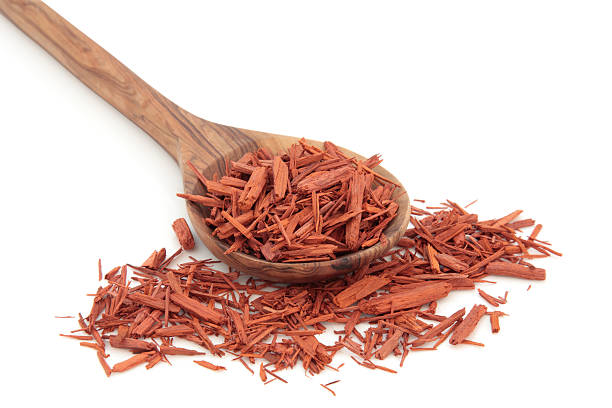Sandalwood
Botanical Name: Santaium albam
Indian Name: Chandan
Origin, Distribution and Composition

Its trade name Sandalwood is based on its English name.
It is a medium-sized evergreen tree with almost drooping branches, dark rough bark and scented mature wood.
It has opposite leaves, shining on the upper surface, with small dull purplish flowers in small bunches and roundish, purple-black succulent fruits.
It is believed to be indigenous to India. It is cultivated in Karnataka, Coimbatore and the southern parts of Tamil Nadu. It also grows wild.
This tree occupies a very important place in Hindu religious rituals. The Parsi's use it for the fire in their temples.
Its wood was highly prizes during ancient India and China, owing to its sweet odour. This tree finds a mention in the earliest Sanskrit and Chinese literature.
Healing Power and Curative Properties of Sandalwood
Both the powder, and the essential oil obtained after fractional distillation, have been used in Ayurveda for many centuries. The wood is bitter, sedative, cooling and a cardiac tonic.
It is useful in arresting secretion or bleeding and in promoting the flow of urine. Moreover, its oil is a stimulant and an antiseptic- It has a soothing effect on the skin and mucous membranes.
Genito-Urinary Disorders
Its powder mixed with milk or made into pills, as also its oil, is considered beneficial in the treatment of gonorrhoea. The oil is used in treating, dysuria (painful and difficult urination) and cystitis (inflammation of die bladder).
It is taken in doses of five drops in the beginning and gradually increased to 10 to 30 drops. Its efficacy can be increased by the addition of ajwain water or infusion of ginger.
Gastric Irritability
This is valuable in gastric irritability. About 22 grams of a watery emulsion of the wood mixed with sugar, honey and rice water, should be administered in the treatment of such a condition.
Dysentery
It is also beneficial in the treatment of dysentery. It should be administered as for gastric irritability.
Prickly Heat
Its paste is a popular household remedy for prickly heal. It prevents excessive sweating and heals inflamed skin. Dry powder can be mixed in rose water and applied over parts where there is profuse sweating.
Skin Diseases
An emulsion or a paste of the wood is a cooling dressing in inflammatory and eruptive skin diseases such as erysipelas, an inflammatory disease of the face, an itchy eruption. The oil is useful for scabies too.
This oil mixed with twice its quantity of mustard oil is used for removing pimples. In summer, regular application of the paste on the body, especially for children, has a refreshing effect, which heals any tiny infected spots.
Fever
Its paste applied on the temple relieves headache and brings down the temperature in fevers.
Return from this Page to List of herbs



